Financial Accounting Report: Transactions, Statements, and Standards
VerifiedAdded on 2023/06/18
|27
|4441
|406
Report
AI Summary
This financial accounting report covers recording business transactions using double-entry bookkeeping, preparing final accounts, and performing reconciliations. It discusses various business transactions, single and double-entry systems, and trial balances. Scenario 1 includes journal entries, ledger accounts, and a trial balance. It also differentiates between financial statements and reporting, explains fundamental accounting principles like accrual, conservatism, cost, full disclosure, and going concern. Scenario 2 involves bank reconciliation statements and control accounts. The report emphasizes the importance of accurate financial records for effective decision-making and competitive advantage.
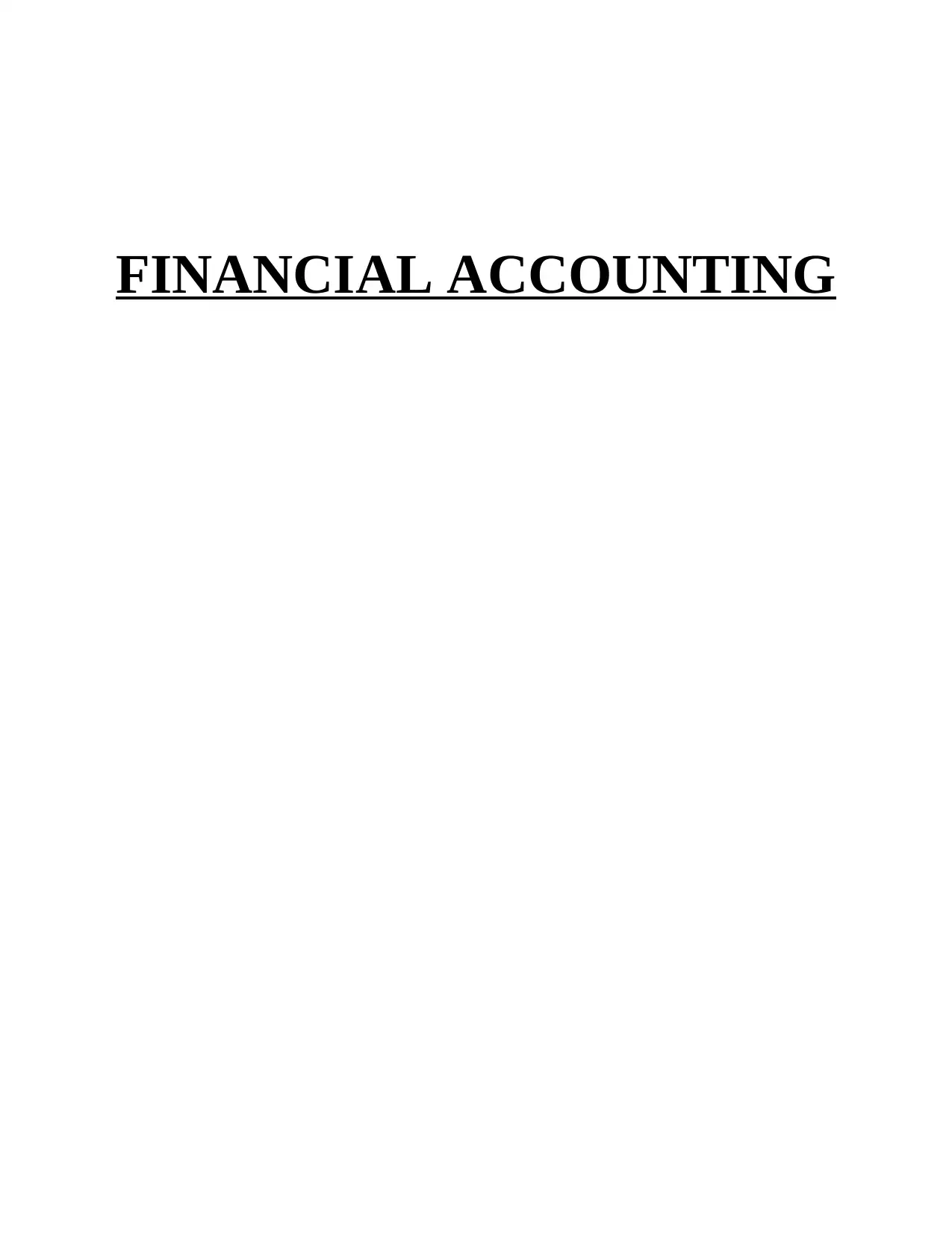
FINANCIAL ACCOUNTING
Paraphrase This Document
Need a fresh take? Get an instant paraphrase of this document with our AI Paraphraser

TABLE OF CONTENTS
INTRODUCTION.......................................................................................................................................3
MAIN BODY..............................................................................................................................................3
SCENARIO 1..............................................................................................................................................3
Question 1...............................................................................................................................................3
Question 2...............................................................................................................................................4
Question 3.............................................................................................................................................11
Question 4.............................................................................................................................................12
Question 5.............................................................................................................................................14
Question 6.............................................................................................................................................16
Question 7.............................................................................................................................................18
SCENARIO 2............................................................................................................................................19
Question 1.............................................................................................................................................19
Question 2.............................................................................................................................................20
Question 3.............................................................................................................................................21
Question 4.............................................................................................................................................21
Question 5.............................................................................................................................................23
CONCLUSION.........................................................................................................................................25
REFERENCES..........................................................................................................................................27
INTRODUCTION.......................................................................................................................................3
MAIN BODY..............................................................................................................................................3
SCENARIO 1..............................................................................................................................................3
Question 1...............................................................................................................................................3
Question 2...............................................................................................................................................4
Question 3.............................................................................................................................................11
Question 4.............................................................................................................................................12
Question 5.............................................................................................................................................14
Question 6.............................................................................................................................................16
Question 7.............................................................................................................................................18
SCENARIO 2............................................................................................................................................19
Question 1.............................................................................................................................................19
Question 2.............................................................................................................................................20
Question 3.............................................................................................................................................21
Question 4.............................................................................................................................................21
Question 5.............................................................................................................................................23
CONCLUSION.........................................................................................................................................25
REFERENCES..........................................................................................................................................27

INTRODUCTION
Financial Accounting (FA) is process of recording, summarizing and analyzing the
monetary transactions in order to have efficient decision making procedure. In the current
scenario, there is crucial requirement to gain competitive advantages through developing
systematic procedure for having effectual practices in industry to lead the company from similar
organization. The current report will include the description regarding business transactions,
double and single entry system, trail balance, difference between financial statement and
reporting, fundamental principles of accounting, etc. the practical exposure will be given by
preparing journal ledge, profit & loss account, cash flow and reconciliation statement, etc
MAIN BODY
SCENARIO 1
Question 1
Business transaction is related with interchanging goods and services between two or
more parties for the purpose accomplishing organizational goals such as profitability, higher
conversion rate, etc. There are several types of business transactions which are undertaken by
firms in industry in order to derive sufficient accomplishment of objectives. There are several
types of business transactions which are performed in form of cash and credit for the purpose of
purchasing & selling of raw materials, current and fixed assets and paying off debts, salaries,
interest, dividends, etc. In addition to this, these all practices are exerted for exchange of value.
It is measurable in terms of money which highly impacts the financial position of organization.
There are several events which can be referred as commercial transactions as they do not have
the characteristics like affecting financial position, monetary value, etc.
Single entry is the characterized by the fact that there is only one side recording of
transaction. It does not enable the firm to have effective understanding of particular transaction
to make appropriate decision making (Roberts, J., 2021). It does not associated with the formal
training and utilized by the small businesses to make the process of carrying forward activities
in comparatively easy manner due to characteristics of simplicity and cost effectiveness. In book
Financial Accounting (FA) is process of recording, summarizing and analyzing the
monetary transactions in order to have efficient decision making procedure. In the current
scenario, there is crucial requirement to gain competitive advantages through developing
systematic procedure for having effectual practices in industry to lead the company from similar
organization. The current report will include the description regarding business transactions,
double and single entry system, trail balance, difference between financial statement and
reporting, fundamental principles of accounting, etc. the practical exposure will be given by
preparing journal ledge, profit & loss account, cash flow and reconciliation statement, etc
MAIN BODY
SCENARIO 1
Question 1
Business transaction is related with interchanging goods and services between two or
more parties for the purpose accomplishing organizational goals such as profitability, higher
conversion rate, etc. There are several types of business transactions which are undertaken by
firms in industry in order to derive sufficient accomplishment of objectives. There are several
types of business transactions which are performed in form of cash and credit for the purpose of
purchasing & selling of raw materials, current and fixed assets and paying off debts, salaries,
interest, dividends, etc. In addition to this, these all practices are exerted for exchange of value.
It is measurable in terms of money which highly impacts the financial position of organization.
There are several events which can be referred as commercial transactions as they do not have
the characteristics like affecting financial position, monetary value, etc.
Single entry is the characterized by the fact that there is only one side recording of
transaction. It does not enable the firm to have effective understanding of particular transaction
to make appropriate decision making (Roberts, J., 2021). It does not associated with the formal
training and utilized by the small businesses to make the process of carrying forward activities
in comparatively easy manner due to characteristics of simplicity and cost effectiveness. In book
⊘ This is a preview!⊘
Do you want full access?
Subscribe today to unlock all pages.

Trusted by 1+ million students worldwide

system double entry system is where entry to an account needs corresponding entry to different
head. This type of system has the equal and corresponding sides known as debit & credit. It
standardize the process and maintain the accuracy of through improving efficiency via providing
reliable information by preparing financial statements. It helps in reducing errors and omission
in respect to derive sufficient ability to decline the possibility of inaccurate decisions that can
influence business procedure.
Trial Balance is a basically a worksheet that is concerned to provide information through
summarizing ledger balances. The common purpose for formulating trail balance is to ensure
entries in mathematically manner are correct. Firm get the base for preparing financial statements
through identifying and improving errors at initial stage by giving emphasis on trail balance. The
validity of accuracy of trial balance is ensured by focusing on its both debit and debit side
through assuring that these are equal (Blaufus and Hoffmann, –2020). There are several purposes
for which company prepares this so that various benefits can be obtained. The significant which
organizations get through executing trial balance includes arithmetic accuracy, preparation of
financial statements, rectifying errors, making adjustments, comparatively analysis, effective
decision am king via formulating audit reports, etc
Question 2
1. Journal Entries for the month of June 2016
Date Particulars L.F Debit Credit
1-Jun Cash A/C Dr. 65000
To Capital A/C 65000
(Being capital invested for
starting company)
2-Jun Purchase A/C Dr. 8000
To Trade payables A/C 8000
(Being goods purchased on
credit)
head. This type of system has the equal and corresponding sides known as debit & credit. It
standardize the process and maintain the accuracy of through improving efficiency via providing
reliable information by preparing financial statements. It helps in reducing errors and omission
in respect to derive sufficient ability to decline the possibility of inaccurate decisions that can
influence business procedure.
Trial Balance is a basically a worksheet that is concerned to provide information through
summarizing ledger balances. The common purpose for formulating trail balance is to ensure
entries in mathematically manner are correct. Firm get the base for preparing financial statements
through identifying and improving errors at initial stage by giving emphasis on trail balance. The
validity of accuracy of trial balance is ensured by focusing on its both debit and debit side
through assuring that these are equal (Blaufus and Hoffmann, –2020). There are several purposes
for which company prepares this so that various benefits can be obtained. The significant which
organizations get through executing trial balance includes arithmetic accuracy, preparation of
financial statements, rectifying errors, making adjustments, comparatively analysis, effective
decision am king via formulating audit reports, etc
Question 2
1. Journal Entries for the month of June 2016
Date Particulars L.F Debit Credit
1-Jun Cash A/C Dr. 65000
To Capital A/C 65000
(Being capital invested for
starting company)
2-Jun Purchase A/C Dr. 8000
To Trade payables A/C 8000
(Being goods purchased on
credit)
Paraphrase This Document
Need a fresh take? Get an instant paraphrase of this document with our AI Paraphraser
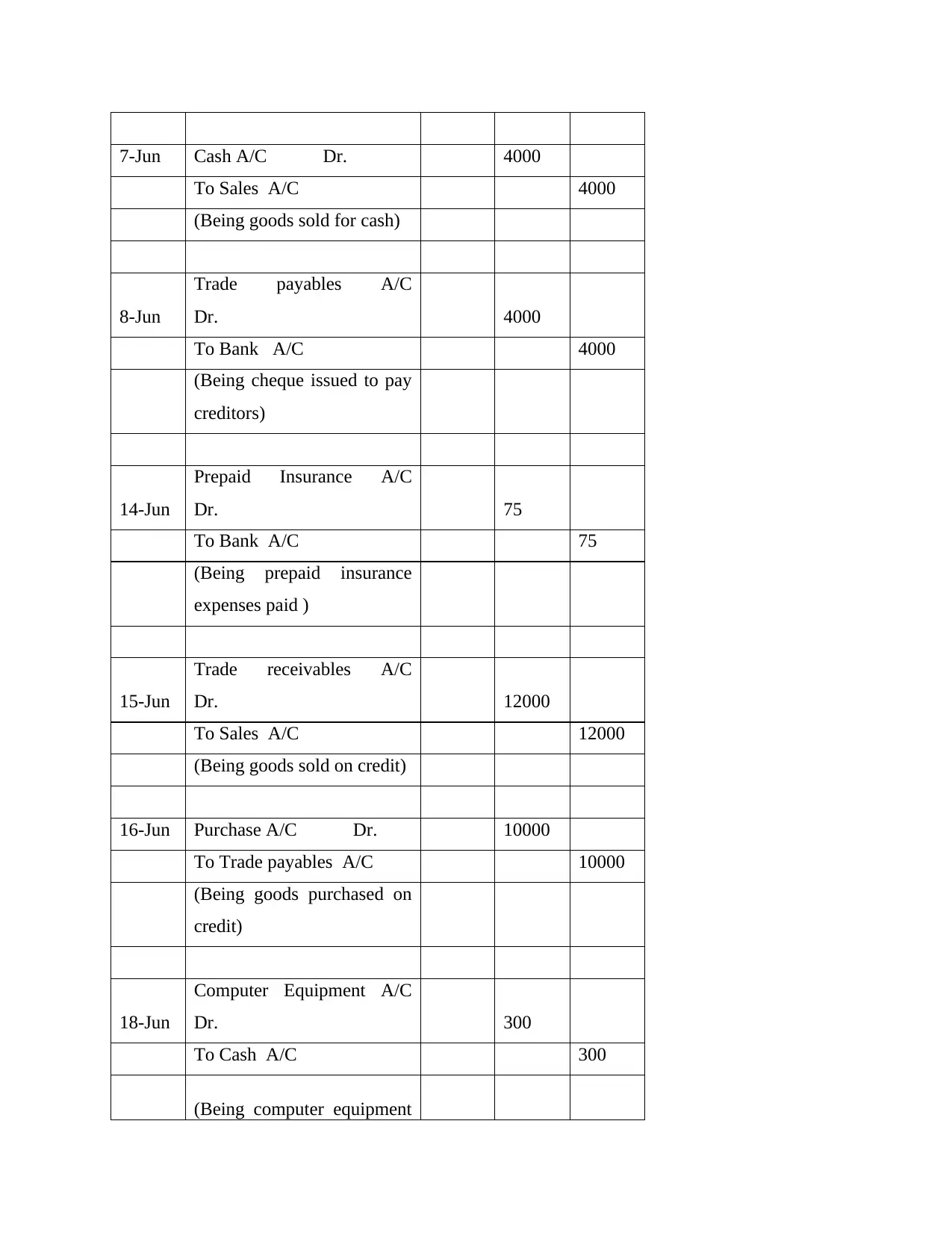
7-Jun Cash A/C Dr. 4000
To Sales A/C 4000
(Being goods sold for cash)
8-Jun
Trade payables A/C
Dr. 4000
To Bank A/C 4000
(Being cheque issued to pay
creditors)
14-Jun
Prepaid Insurance A/C
Dr. 75
To Bank A/C 75
(Being prepaid insurance
expenses paid )
15-Jun
Trade receivables A/C
Dr. 12000
To Sales A/C 12000
(Being goods sold on credit)
16-Jun Purchase A/C Dr. 10000
To Trade payables A/C 10000
(Being goods purchased on
credit)
18-Jun
Computer Equipment A/C
Dr. 300
To Cash A/C 300
(Being computer equipment
To Sales A/C 4000
(Being goods sold for cash)
8-Jun
Trade payables A/C
Dr. 4000
To Bank A/C 4000
(Being cheque issued to pay
creditors)
14-Jun
Prepaid Insurance A/C
Dr. 75
To Bank A/C 75
(Being prepaid insurance
expenses paid )
15-Jun
Trade receivables A/C
Dr. 12000
To Sales A/C 12000
(Being goods sold on credit)
16-Jun Purchase A/C Dr. 10000
To Trade payables A/C 10000
(Being goods purchased on
credit)
18-Jun
Computer Equipment A/C
Dr. 300
To Cash A/C 300
(Being computer equipment
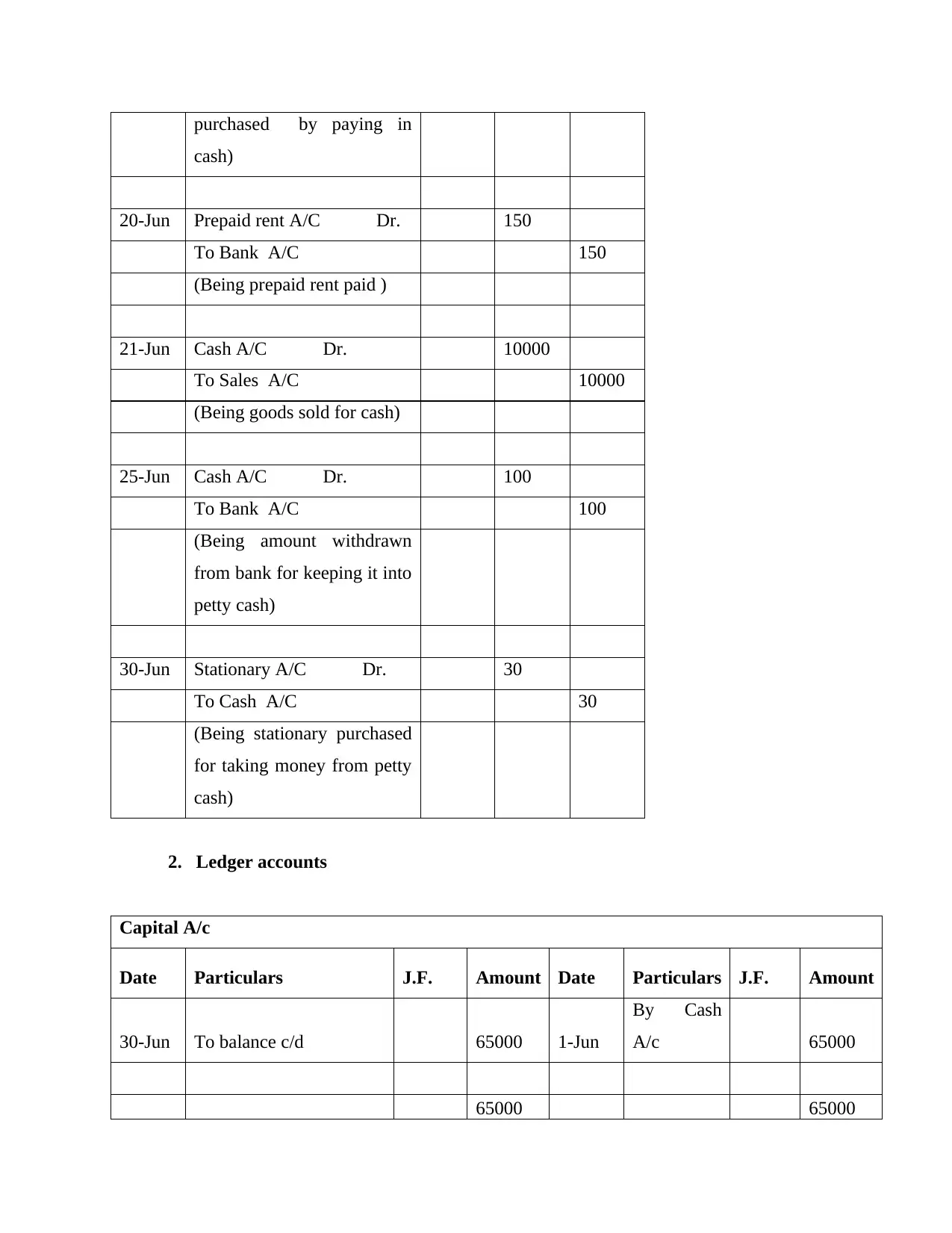
purchased by paying in
cash)
20-Jun Prepaid rent A/C Dr. 150
To Bank A/C 150
(Being prepaid rent paid )
21-Jun Cash A/C Dr. 10000
To Sales A/C 10000
(Being goods sold for cash)
25-Jun Cash A/C Dr. 100
To Bank A/C 100
(Being amount withdrawn
from bank for keeping it into
petty cash)
30-Jun Stationary A/C Dr. 30
To Cash A/C 30
(Being stationary purchased
for taking money from petty
cash)
2. Ledger accounts
Capital A/c
Date Particulars J.F. Amount Date Particulars J.F. Amount
30-Jun To balance c/d 65000 1-Jun
By Cash
A/c 65000
65000 65000
cash)
20-Jun Prepaid rent A/C Dr. 150
To Bank A/C 150
(Being prepaid rent paid )
21-Jun Cash A/C Dr. 10000
To Sales A/C 10000
(Being goods sold for cash)
25-Jun Cash A/C Dr. 100
To Bank A/C 100
(Being amount withdrawn
from bank for keeping it into
petty cash)
30-Jun Stationary A/C Dr. 30
To Cash A/C 30
(Being stationary purchased
for taking money from petty
cash)
2. Ledger accounts
Capital A/c
Date Particulars J.F. Amount Date Particulars J.F. Amount
30-Jun To balance c/d 65000 1-Jun
By Cash
A/c 65000
65000 65000
⊘ This is a preview!⊘
Do you want full access?
Subscribe today to unlock all pages.

Trusted by 1+ million students worldwide
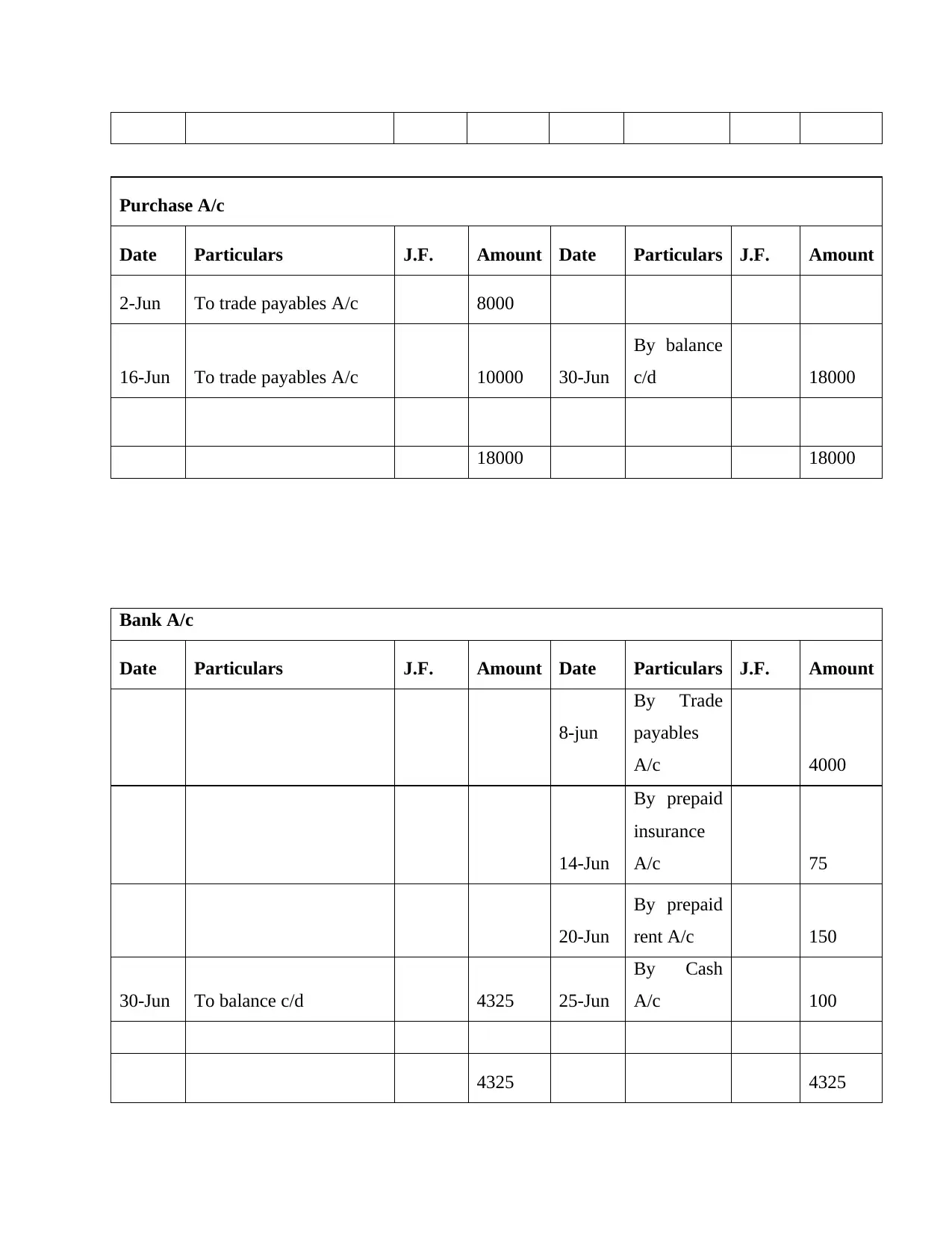
Purchase A/c
Date Particulars J.F. Amount Date Particulars J.F. Amount
2-Jun To trade payables A/c 8000
16-Jun To trade payables A/c 10000 30-Jun
By balance
c/d 18000
18000 18000
Bank A/c
Date Particulars J.F. Amount Date Particulars J.F. Amount
8-jun
By Trade
payables
A/c 4000
14-Jun
By prepaid
insurance
A/c 75
20-Jun
By prepaid
rent A/c 150
30-Jun To balance c/d 4325 25-Jun
By Cash
A/c 100
4325 4325
Date Particulars J.F. Amount Date Particulars J.F. Amount
2-Jun To trade payables A/c 8000
16-Jun To trade payables A/c 10000 30-Jun
By balance
c/d 18000
18000 18000
Bank A/c
Date Particulars J.F. Amount Date Particulars J.F. Amount
8-jun
By Trade
payables
A/c 4000
14-Jun
By prepaid
insurance
A/c 75
20-Jun
By prepaid
rent A/c 150
30-Jun To balance c/d 4325 25-Jun
By Cash
A/c 100
4325 4325
Paraphrase This Document
Need a fresh take? Get an instant paraphrase of this document with our AI Paraphraser

Trade receivables A/C
Date Particulars J.F. Amount Date Particulars J.F. Amount
15-Jun To Sales A/c 12000 30-Jun
By balance
c/d 12000
12000 12000
Cash A/C
Date Particulars J.F. Amount Date Particulars J.F. Amount
1-Jun To Capital A/C 65000 18-Jun
By Computer
Equipment A/C
Dr. 300
7-Jun To Sales A/C 4000
21-Jun To Sales A/C 10000 30-Jun By Stationary A/C 30
25-Jun To Bank A/C 100 30-Jun By balance c/d 78770
79100 79100
Trade payables A/C
Date Particulars J.F. Amount Date Particulars J.F. Amount
8-Jun To Bank A/c 4000 2-Jun
By Purchase
A/c 8000
30-Jun To balance c/d 14000 16-Jun
By Purchase
A/c 10000
Date Particulars J.F. Amount Date Particulars J.F. Amount
15-Jun To Sales A/c 12000 30-Jun
By balance
c/d 12000
12000 12000
Cash A/C
Date Particulars J.F. Amount Date Particulars J.F. Amount
1-Jun To Capital A/C 65000 18-Jun
By Computer
Equipment A/C
Dr. 300
7-Jun To Sales A/C 4000
21-Jun To Sales A/C 10000 30-Jun By Stationary A/C 30
25-Jun To Bank A/C 100 30-Jun By balance c/d 78770
79100 79100
Trade payables A/C
Date Particulars J.F. Amount Date Particulars J.F. Amount
8-Jun To Bank A/c 4000 2-Jun
By Purchase
A/c 8000
30-Jun To balance c/d 14000 16-Jun
By Purchase
A/c 10000

18000 18000
Sales A/c
Date Particulars J.F. Amount Date Particulars J.F. Amount
7-Jun
By Cash
A/c 4000
15-Jun
By trade
receivables
A/c 12000
30-Jun To balance c/d 26000 21-Jun
By Cash
A/c 10000
26000 26000
Computer Equipment A/c
Date Particulars J.F. Amount Date Particulars J.F. Amount
18-Jun To Cash A/c 300 30-Jun
By balance
c/d 300
300 300
Sales A/c
Date Particulars J.F. Amount Date Particulars J.F. Amount
7-Jun
By Cash
A/c 4000
15-Jun
By trade
receivables
A/c 12000
30-Jun To balance c/d 26000 21-Jun
By Cash
A/c 10000
26000 26000
Computer Equipment A/c
Date Particulars J.F. Amount Date Particulars J.F. Amount
18-Jun To Cash A/c 300 30-Jun
By balance
c/d 300
300 300
⊘ This is a preview!⊘
Do you want full access?
Subscribe today to unlock all pages.

Trusted by 1+ million students worldwide

Prepaid Rent A/c
Date Particulars J.F. Amount Date Particulars J.F. Amount
20-Jun To Bank A/c 150 30-Jun
By balance
c/d 150
150 150
Stationary A/c
Date Particulars J.F. Amount Date Particulars J.F. Amount
30-Jun To Cash A/c 30 30-Jun
By balance
c/d 30
30 30
Prepaid insurance A/c
Date Particulars J.F. Amount Date Particulars J.F. Amount
14-Jun To Bank A/c 75 30-Jun
By balance
c/d 75
75 75
3 Trial Balance:
Particulars Debit Credit
Cash A/c 78770
Date Particulars J.F. Amount Date Particulars J.F. Amount
20-Jun To Bank A/c 150 30-Jun
By balance
c/d 150
150 150
Stationary A/c
Date Particulars J.F. Amount Date Particulars J.F. Amount
30-Jun To Cash A/c 30 30-Jun
By balance
c/d 30
30 30
Prepaid insurance A/c
Date Particulars J.F. Amount Date Particulars J.F. Amount
14-Jun To Bank A/c 75 30-Jun
By balance
c/d 75
75 75
3 Trial Balance:
Particulars Debit Credit
Cash A/c 78770
Paraphrase This Document
Need a fresh take? Get an instant paraphrase of this document with our AI Paraphraser
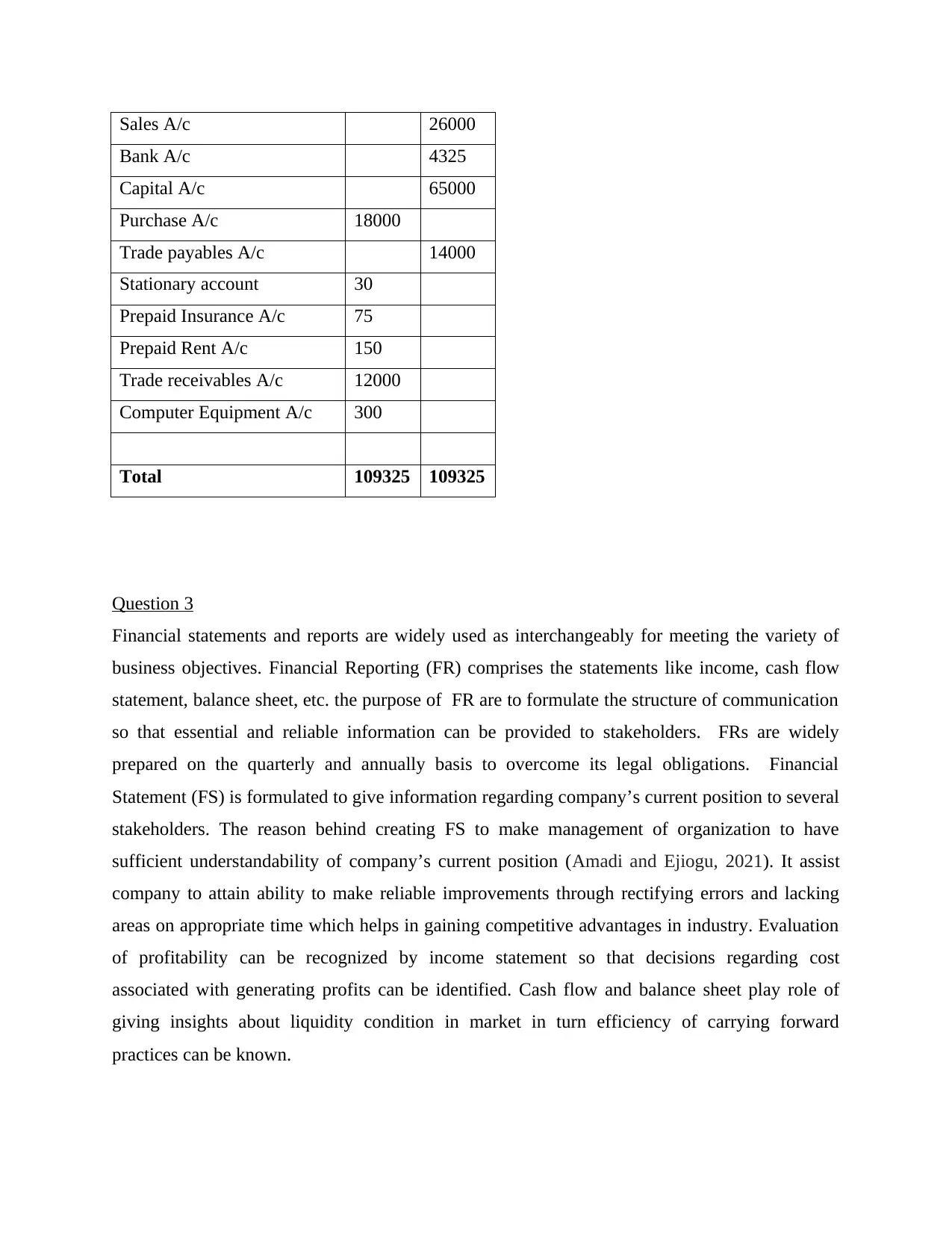
Sales A/c 26000
Bank A/c 4325
Capital A/c 65000
Purchase A/c 18000
Trade payables A/c 14000
Stationary account 30
Prepaid Insurance A/c 75
Prepaid Rent A/c 150
Trade receivables A/c 12000
Computer Equipment A/c 300
Total 109325 109325
Question 3
Financial statements and reports are widely used as interchangeably for meeting the variety of
business objectives. Financial Reporting (FR) comprises the statements like income, cash flow
statement, balance sheet, etc. the purpose of FR are to formulate the structure of communication
so that essential and reliable information can be provided to stakeholders. FRs are widely
prepared on the quarterly and annually basis to overcome its legal obligations. Financial
Statement (FS) is formulated to give information regarding company’s current position to several
stakeholders. The reason behind creating FS to make management of organization to have
sufficient understandability of company’s current position (Amadi and Ejiogu, 2021). It assist
company to attain ability to make reliable improvements through rectifying errors and lacking
areas on appropriate time which helps in gaining competitive advantages in industry. Evaluation
of profitability can be recognized by income statement so that decisions regarding cost
associated with generating profits can be identified. Cash flow and balance sheet play role of
giving insights about liquidity condition in market in turn efficiency of carrying forward
practices can be known.
Bank A/c 4325
Capital A/c 65000
Purchase A/c 18000
Trade payables A/c 14000
Stationary account 30
Prepaid Insurance A/c 75
Prepaid Rent A/c 150
Trade receivables A/c 12000
Computer Equipment A/c 300
Total 109325 109325
Question 3
Financial statements and reports are widely used as interchangeably for meeting the variety of
business objectives. Financial Reporting (FR) comprises the statements like income, cash flow
statement, balance sheet, etc. the purpose of FR are to formulate the structure of communication
so that essential and reliable information can be provided to stakeholders. FRs are widely
prepared on the quarterly and annually basis to overcome its legal obligations. Financial
Statement (FS) is formulated to give information regarding company’s current position to several
stakeholders. The reason behind creating FS to make management of organization to have
sufficient understandability of company’s current position (Amadi and Ejiogu, 2021). It assist
company to attain ability to make reliable improvements through rectifying errors and lacking
areas on appropriate time which helps in gaining competitive advantages in industry. Evaluation
of profitability can be recognized by income statement so that decisions regarding cost
associated with generating profits can be identified. Cash flow and balance sheet play role of
giving insights about liquidity condition in market in turn efficiency of carrying forward
practices can be known.

Financial reporting is used to provide data for the purpose of decision making whereas
statements are means of communicating information regarding monetary condition, stability, etc.
there are several types of stakeholders who are interested in utilizing the information provided in
order to have effective decision making (Filusch, 2021). The stakeholders are comprises
employees, owners, suppliers, investors, financial institutions, analyst, banks, competitors, etc
that are related to either internal or external business environment. The main purpose of investor
is to utilized given information is to have ability to formulate effective decision making.
Company requires giving reliable, relevant, timeliness and other type of qualitative
characteristics in its reports and statements so that trustworthiness in industry can be achieved.
This form of features helps inventors, suppliers, lender, etc to be confident about company’s
process and make valid decisions (Weygandt, Kimmel, and Kieso, 2018). Lenders, suppliers, etc
largely focus on the liquid position so that can get assurance of easily obtaining of their provided
funds. Organization requires maintaining appropriate and timely information providing system
with help of these reports. Internal as well external stakeholders become able to compare current
performance with previous so that potential growth of company to fulfill motive of higher
profitability can be assessed. Management of firm can determine needed improvements through
identifying lacking areas in turn respective course of action for achieving improvement can done.
Competitors of industry as well concentrate on financial information of similar organization to
assess data about competitive advantages like pricing strategy, differentiation, etc can be known
to make suitable action for getting success in sector.
Question 4
Accounting principles are the rules which helps firm to get guidance in form of having smooth
functioning through maintain appropriate balance in its business practices. Different fundaments
principles of accounting are important for all types of entities irrespective of their scale of
operation.
Accrual Principle
It is associated with recording the business transactions in accounting period in which it
has took place. This particular principle is basically concerned with making the procedure of
recording, analyzing and controlling financial information in effectual manner. In addition to
this, it is significant for the company to evaluate accurate condition of company in industry in
statements are means of communicating information regarding monetary condition, stability, etc.
there are several types of stakeholders who are interested in utilizing the information provided in
order to have effective decision making (Filusch, 2021). The stakeholders are comprises
employees, owners, suppliers, investors, financial institutions, analyst, banks, competitors, etc
that are related to either internal or external business environment. The main purpose of investor
is to utilized given information is to have ability to formulate effective decision making.
Company requires giving reliable, relevant, timeliness and other type of qualitative
characteristics in its reports and statements so that trustworthiness in industry can be achieved.
This form of features helps inventors, suppliers, lender, etc to be confident about company’s
process and make valid decisions (Weygandt, Kimmel, and Kieso, 2018). Lenders, suppliers, etc
largely focus on the liquid position so that can get assurance of easily obtaining of their provided
funds. Organization requires maintaining appropriate and timely information providing system
with help of these reports. Internal as well external stakeholders become able to compare current
performance with previous so that potential growth of company to fulfill motive of higher
profitability can be assessed. Management of firm can determine needed improvements through
identifying lacking areas in turn respective course of action for achieving improvement can done.
Competitors of industry as well concentrate on financial information of similar organization to
assess data about competitive advantages like pricing strategy, differentiation, etc can be known
to make suitable action for getting success in sector.
Question 4
Accounting principles are the rules which helps firm to get guidance in form of having smooth
functioning through maintain appropriate balance in its business practices. Different fundaments
principles of accounting are important for all types of entities irrespective of their scale of
operation.
Accrual Principle
It is associated with recording the business transactions in accounting period in which it
has took place. This particular principle is basically concerned with making the procedure of
recording, analyzing and controlling financial information in effectual manner. In addition to
this, it is significant for the company to evaluate accurate condition of company in industry in
⊘ This is a preview!⊘
Do you want full access?
Subscribe today to unlock all pages.

Trusted by 1+ million students worldwide
1 out of 27
Related Documents
Your All-in-One AI-Powered Toolkit for Academic Success.
+13062052269
info@desklib.com
Available 24*7 on WhatsApp / Email
![[object Object]](/_next/static/media/star-bottom.7253800d.svg)
Unlock your academic potential
Copyright © 2020–2025 A2Z Services. All Rights Reserved. Developed and managed by ZUCOL.





